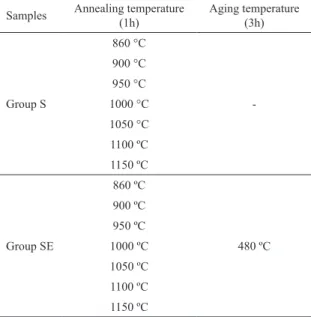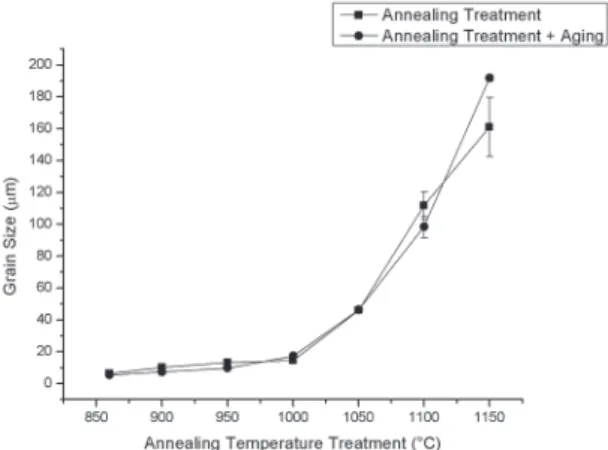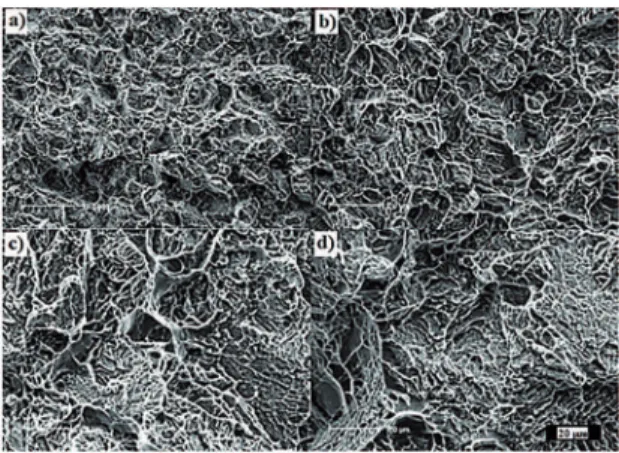Inluence of Solution Annealing on Microstructure and Mechanical Properties of Maraging
300 Steel
Venceslau Xavier Lima Filhoa*, Isabel Ferreira Barrosa, Hamilton Ferreira Gomes de Abreua
Received: March 29, 2016; Revised: August 27, 2016; Accepted: October 20, 2016
Maraging 300 belongs to a family of metallic materials with extremely high mechanical strength and good toughness. Some works have been published about aging temperatures that improve ultimate strength resistance with acceptable toughness levels in this steel family, where the prior austenite
grain size obtained by diferent solution annealing temperature inluence in the inal mechanical
properties. Solution annealing temperatures ranging from 860 °C to 1150 ºC and were kept constant
until the aging temperature. These treatments were used in order to investigate their inluence on the
microstructure and mechanical properties of maraging steel 300, especially with regard to toughness. The characterization of the microstructure was performed by optical microscopy, scanning electron
microscope (SEM) and X-ray difraction (XRD). Mechanical properties were evaluated by Rockwell
C hardness and Charpy impact tests. The results showed that there is a temperature range where one can get some improvement in toughness without a large loss of mechanical strength.
Keywords: maraging 300, heat treatment, microstructure, toughness
* e-mail: venceslau@ifce.edu.br
1. Introduction
Maraging steels are a family of metallic materials with extremely high mechanical strength and good toughness1.
The maraging steels have excellent formability in the solution annealed state and a great ability to harden by aging2. Any
cooling rate leads to the formation of a martensitic structure BCC only in the solubilization treatment, however, may occur reversal of austenitic phase at high temperatures aging treatment. This martensite is ductile and reasonably cold workable consequence of the low-carbon and high nickel content in their chemical composition. According to Sinha
et al.3, grain growth in maraging steel is very complex due to the inluence of the alloying elements present, which in turn, interact diferently with grain boundaries. Another
factor that can explain this event is the precipitation of TiC and Ti (CN)3-6.
Literature also shows that maraging steel increases mechanical strength when subjected to aging heat treatments in the range 440 °C to 650 °C, depending on the properties that are desired to reach7. This heat treatment, in turn, in
addition to harden the material, particularly at temperatures above 450 °C may lead to precipitation of some phases, such as Ni3 (Mo, Ti), Fe2Mo 8.
This study aims to evaluate diferent solution annealing temperatures, how they inluence grain size, toughness and ultimate strength after inal aging.
2. Material and Methods
A maraging 300 steel round bar produced by vacuum induction melting process (VIM) followed by vacuum arc
reining process (VAR), hot forged and solution annealed at
860 °C (for 10 hours to complete homogenization of the ingot) was used for this experiment. The chemical composition of the steel is presented in Table 1. The steel bar was cold-rolled
and cut to produce samples for the diferent tests performed.
Samples were solution annealed at 860, 900, 950, 1000, 1050, 1100 e 1150 ºC for one hour. Part of samples were aged at 480 °C for 3 hours to achieve peak hardness9. Many
studies suggest the use of solution annealed heat treatments at 820°C and aging at 480°C as been the ideal for maraging 300 steel. This condition was exaustly tested with results published on the literatura and were used in this study for comparison referencial1,3,9.
Samples were quenched in water after each heat treatments to suppress the thermal embrittlement phenomena, which is normally observed in maraging steels after exposure to temperatures above 1100 °C, as reported in previous examination10.
Table 2 presents a summary of the heat treatments performed.
Microstructural characterization of samples was performed with a standard metallographic procedure and then etched with ammonium persulfate to reveal microstructure and 2% Nital to reveal the grain boundaries. Microstructural characterization was carried out using a Scanning Electron Microscope FEI XL30. The evaluation of the average grain a Laboratory of Materials Caracterization, Physical Metallurgy and Phase Transformation Research
Table 1: Chemical composition of Maraging 300 steel (wt %).
Ni Mo Co Ti Al C Mn Si
18.4 5.04 9.35 0.76 0.1 0.01 0.02 0.05
Table 2: Summary of heat treatments.
Samples Annealing temperature (1h)
Aging temperature (3h)
Group S
860 °C
-900 °C
950 °C
1000 °C
1050 °C
1100 ºC
1150 ºC
Group SE
860 ºC
480 ºC 900 ºC
950 ºC
1000 ºC
1050 ºC
1100 ºC
1150 ºC
size was performed by measuring the diameter of equivalent area with individual grains, according to the intercept method by ASTM E112 using Image-Pro software on a Microscope Olympus Optical BX51M.
The X-ray difraction was used to characterize the phases
present and was performed in a PANalytical X-Pert.-Pro
difractometer. The parameters to be measured were: copper
tube monochromator scan range angles between 35 and 95 ° with steps of 0.02 ° step time of 2.5 sec and scan speed of 0.008 °/s. Rockwell C hardness and Charpy tests (with subsize dimensions of 7,5x10x55mm) were performed in accordance with the respective ASTM standards.
3. Results
3.1. Microstructure
Microstructural analysis of the Maraging 300 samples in the received condition, revealed a microstructure mainly composed of martensite, as can be seen in Figure 1. The average size of prior austenite grains was 6 μm.
The X-ray difraction analysis presented in Figure 2
shows that the solution annealed and aged samples are essentially composed by the cubic phase martensite(α) which is characteristic of maraging steel.
3.2. Grain Growth
Optical microscopy of annealed samples revealed essentially uniform and equiaxed microstructure of prior
Figure 1: Maraging 300 in the “as received” condition. SEM image
with 5000x magniication.
Figure 2: X-ray Difraction patterns for samples annealed at various
temperatures and aged at 480 °C.
austenite grains, without abnormal grain growth. Figure 3 (a-g) shows typical micrographs of samples annealed at temperatures of 860, 900, 950, 1000, 1050, 1100 and 1150 ºC for 1 hour, where can be observed an increase in the size of the prior austenite grains with the heat treatment temperature.
The curve of prior austenite grain size versus annealing temperature (Figure 4) indicates that the recrystallization finished before 860 ºC and clearly shows that the growth rate is relatively slow between 860 and 1000 °C and quickly rises above 1150 ºC, with values ranging approximately 8 µm at 860 °C to 164 µm for the sample annealed at 1150 °C. Other literatures about 18Ni maraging steels revealed that the prior autenite grain reached close to 140 µm in ref.11 and 190 µm in
ref.1 at the same conditions.
Figure 3: Microstructure of samples solution annealed for 1 hour at a) 860 °C, b) 900 °C, c) 950 °C, d) 1000 °C, e) 1050 °C f) 1100
°C g) 1150 °C. Magniication 500x.
Figure 4: Prior austenite grain size for diferent annealing temperatures.
3.3 Hardness
The efect of annealing and aging on the hardness in the
Maraging samples is shown in Figure 5. We can see that the hardness values for annealing and aged samples are almost double the values for samples subjected only to the solution treatment and that despite the average value of annealing samples in 1000 ° C and aged to show slightly higher than the other, we cannot say that the annealing temperature
caused signiicant changes in hardness values.
Figure 5: Results of the Rockwell Hardness tests of the solution treatment samples and solution treatment + aging samples.
3.4. Toughness
The efects of the aging and solution annealing on
the toughness can be observed by the results of Charpy impact test, of which values are shown in Figure 6. The results show an increase trend of Charpy energy for temperatures between 860 and 1000 °C where upon this temperature tend to fall back to reverse. The material in the condition as received, without aging heat treatment, presented absorbed energy of 48 J in the Charpy impact test. The best result for aged samples was 23 J for the sample solution annealed at 1000 °C and aged for 3 hours at 480 °C.
Figure 6: Charpy impact energy for samples solution annealed and aged at 480 °C.
3.5. Fractography
Figure 7: Cross section of test specimens after the Charpy test presenting ductile fracture for annealing and aged samples. Annealing temperature in ° C (Charpy absorbed energy in J) a) 950 °C (18,39J); b) 1000 °C (23,05J); c) 1050 °C (21,83J), d) 1100 °C (14,87J). The Charpy toughness tests were performed with subsize specimens with cross section 7,5x10mm.
4. Discussion
It is well established that when austenite is heated to higher temperatures or held for a long time annealing the grain size increases. The surface tension force is responsible for this grain growth. It is also expected that the grain growth of austenite result in martensite with lower ultimate strength and toughness12. While for most cases this phenomenon
occurs, in the maraging steel used in this work even with the increase of the grain size was observed increased toughness of the material, particularly when compared the results of solution annealed samples between 860 °C and 1000 °C and aged at 480 °C. Only after the heat treatments performed above 1050 °C was possible to conclude that increased grain caused that reduction on the Charpy energy. In this study it was not observed a sharp decrease in the ultimate strength of this alloy.
Similar behavior was observed by He et al.13 in a maraging
steel without cobalt. They concluded that in samples only solution annealed the tensile strength and toughness were not
inluenced by grain size. According to them, in this condition
there was no change in the martensite spacing or dislocation tangles. Already in the aged samples it was also found that after 1100 °C both the tensile strength and the toughness
sufered a sharp decline. Studies are being continued to have
an explanation for this fact. It is known that increasing the solution temperature responsible for the increase of grain size increases the martensite transformation temperature. The martensitic transformation samples treated above 1100 °C resulted, in the case of maraging without cobalt, in a severe precipitation of Ni3Ti in the grain boundary of the prior austenite ad also in martensite contours. The dissolution of these precipitates can form rich regions in Ni while continuing aging which were more favorable regions for reversion of austenite. Up to a certain amount of reversed austenite can result in an improvement of toughness. Increasing the amount of austenite however toughness decreases.
According to Hou et al.14, maraging steels forged and
solution annealed at temperatures of 750, 800, 850, 900, 950 and 1000 °C for 1 hour and then aged at 500 °C for 2 hours have their mechanical properties reduced with increasing
temperature. They also observed that there was a signiicant
reduction in the impact energy of 60 J to 10 J with respect to temperatures of 750 °C and 1000 °C respectively. This
fact could be conirmed by analyzing the specimen after the
impact test, which indicated that the increase in specimen of solubilization temperature caused a brittle fracture in the specimen. Unlike what was observed by Houet al, in this study the samples treated at 1000 °C and aged at 480 °C presented the best results in terms of impact energy, reaching about 30.5 J and a ductile fracture. For the other samples treated at other temperatures, it was found that despite the low impact energy, all presented ductile fracture after the Charpy test.
The hardness of the samples in turn, even with the variation of temperature and consequently the grain size, showed similar values even for one with the highest impact energy.
As noted by Shaet et al.15, after aging treatments you
can check the formation of small light particles that stand out on the microstructure of the material. These authors assumed that these particles are reverted austenite, which in turn contribute to increased toughness. Many particles like these were observed in the samples that were aged.
5. Conclusions
With the results obtained from the present study in which
we aimed to evaluate the inluence of solution annealing and
aging maraging 300, it was concluded that:
a- The solution annealing at high temperatures contributed to increase grain size of the microstructure;
b- The samples treated at 1000 ° C and aged at 480 ° C showed the best results, particularly with regard to increasing the toughness of the material;
c- The values for the hardness of the material present a small variation with annealing temperature treatment.
6. Acknowledgements
The authors thank the coordination of higher level of personal development - CAPES for promoting the research work.
7. References
1. Yang K, Qu WS, Kong FY, Su GY. Efects of solution treatment
temperature on grain growth and mechanical properties of high strength 18%Ni cobalt free maraging steel. Materials Science and Technology. 2003;19(1):117-124.
2. Pardal JM, Tavares SSM, Fonseca MPC, Abreu HFG, Silva JJM.
Study of the austenite quantiication by X-ray difraction in
3. Sinha PP, Sreekumar K, Natarajan A, Nagarajan KV. Grain growth in 18Ni 1800 MPa maraging steel. Journal of Materials Science. 1991;26(15):4155-4159.
4. Johnson WC, Stein DF. A study of grain boundary segregants in
thermally embrittled maraging steel. Metallurgical Transactions. 1974;5(3):549-554.
5. Ashbrook RW, Marder AR. The efect of initial carbide morphology
and abnormal grain growth in decarburized low carbon steel.
Metallurgical Transactions A. 1985;16(5):897-906.
6. Burke JE, Turnbull D. Recrystallization and grain growth. Progress in Metal Physics. 1952;3: 220, IN11, 245, IN13, 267, IN15, 275-244-IN12-266-IN14-274-292.
7. Magnée A, Drapier JM, Dumont J, Coutsouradis D, Habraken
L. Cobalt-containing high-strength steels. Brussels: Centre d’Information du Cobalt; 1974.
8. Pardal JM, Tavares SSM, Terra VF, Silva MR, Santos DR.
Modeling of precipitation hardening during the aging and overaging of 18Ni-Co-Mo-Ti maraging 300 steel. Journal of Alloys and Compounds. 2005;393(1-2):109-113.
9. Decker RF. Source book on maraging steels: A comprehensive collection of outstanding articles from the periodical and reference literature. Materials Park: ASM International; 1979.
10. Rack HJ. Age hardening-grain size relationships in 18Ni maraging steels. Materials Science and Engineering. 1978;34(3):263-270.
11. Liu K, Shan YY, Yang ZY, Liang JX, Lu L, Yang K. Efect of
heat treatment on prior grain size and mechanical property of a maraging stainless steel. Journal of Materials Science & Technology. 2006;22(6):769-774.
12. Il’ina VP, Troitskaya VA. Efect of low-temperature quenching
on the microstructure and capacity for corrosion cracking steel
03Kh11N10M2T-VD. Metal Science and Heat Treatment. 2000;42(2):53-56.
13. He Y, Liu K, Yang K. Efect of solution temperature on fracture toughness and microstructure of ultra-puriied 18Ni(350)
maraging steel. Acta Metallurgica Sinica. 2003;39:381-386.
14. Hou H, Qi L, Zhao YH. Efect of austenitizing temperature
on the mechanical properties of high-strength maraging steel.
Materials Science and Engineering: A. 2013;587:209-212.


